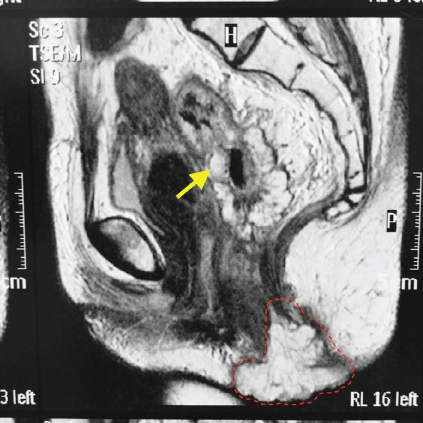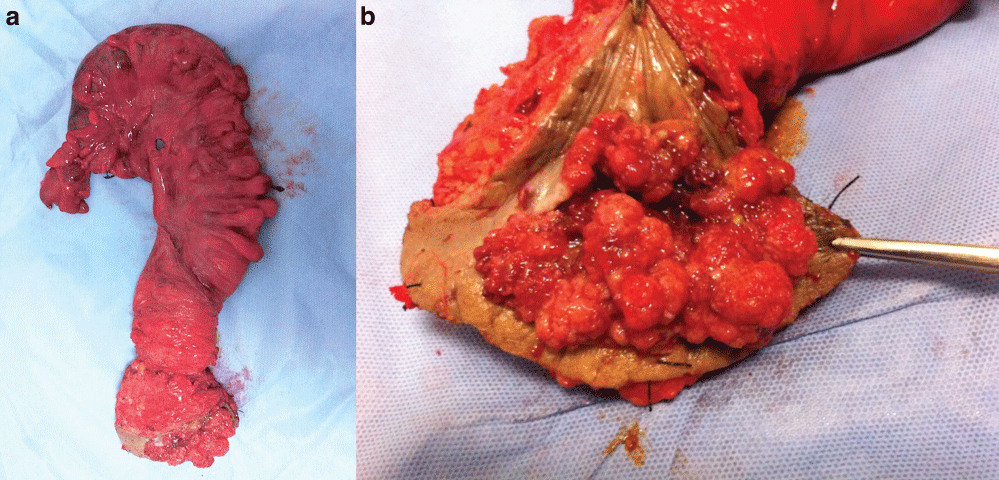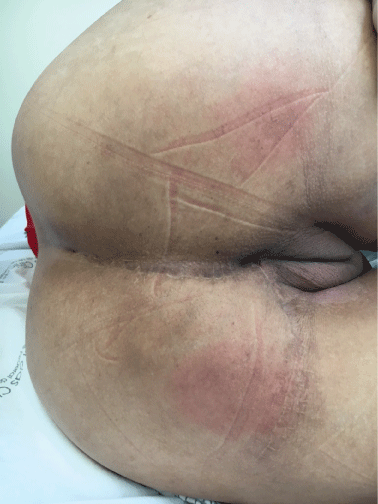Rectal cancer metastasis to an anal fissure is an extremely rare condition, being the most common dissemination mechanisms lymphatic and blood vessels. However, it is possible that feces carry tumor cells from proximal regions of the intestine to implant in injured areas of the anal mucosa, such as anal fistula, anal fissure or hemorrhoidectomy wound.
It is presented a rare case of colorectal cancer metastasis to an anal fissure and a literature review. A 49-year-old woman was diagnosed with mid rectum adenocarcinoma and anal fissure. Initially, she refused the treatment and discontinued medical assistance. Nine months later she returned to the hospital complaining of anal pain and decide to resume medical care. She had another tumor in the anal verge without communication with the rectal tumor. Pelvic MRI showed the previous mid rectum tumor associated with an extensive mass affecting both the anal sphincters and the anal margin. The pathological analysis showed that both primary tumor and anal metastasis had the same histological origin. She underwent neoadjuvant chemoradiotherapy treatment and ten weeks later she was submitted to abdominoperineal resection of the rectum with the myocutaneous gluteus flap for perineal reconstruction.
Patients diagnosed with malignant colorectal diseases should always undergo thorough clinical examination of the anal canal to identify benign pathologies that could be site of anal metastasis. In addition, novel studies for the development of noninvasive colon cancer screening tests should be encouraged.
Rectal neoplasms, Neoplasm metastasis, Distal colon, Proximal colon, Fissure in ano
cTNM: Clinical Tumor Staging; MRI: Magnetic Resonance Imaging; pTNM: Pathological Tumor Staging
Colorectal cancer is a malignant neoplasm, currently the third and second most common cancer in men and women, respectively [1]. Metastases are frequent complications since the tumor cells usually spread by lymphatic system to regional lymph nodes, by blood vessels to distant organs such as liver, lungs, bones and brain, or, by direct extension to other abdominal organs as well [2].
Anal metastasis is a rare condition, accounting for 1% of all cases of colorectal metastasis and the implantation of the tumor is usually associated with previous anal injury [3]. In 1954, Guiss [4] reported the first case of rectal cancer metastasis to an anal fistula and after that this unusual colorectal cancer dissemination was described in several clinical reports in which carcinoma cells were implanted in a fistula, fissure or hemorrhoidectomy wound leading to cancer recurrence or synchronic tumors [5].
A large number of colonic epithelial cells are exfoliated daily from the gut and, growth factors from open wound or ulcerated mucosa allows tumor implantation and growth [6]. The diagnosis of anal metastasis is suggested when both proximal bowel and anal cancer have the same histopathological features [7].
The aim of this article is to present a rare case of rectal adenocarcinoma implanted in an anal fissure, resulting in synchronic rectal and anal tumors requiring abdominoperineal resection of the rectum and permanent colostomy for treatment.
A previously healthy 49-year-old female patient was diagnosed with mid rectal adenocarcinoma in April 2014. The preoperative clinical tumor staging (cTNM) at the diagnosis was T4 N1 M0 with mesorectum invasion by pelvic magnetic resonance imaging (MRI) and a probably affected lymph node; abdominal and chest computed tomography did not show metastasis. On physical examination, rigid rectosigmoidoscopy showed a circumferential tumor at 10 cm from the anal verge and she also had an anal acute fissure probably due to defecation strength and constipation. There were no other abnormalities in the proximal colon mucosa after colonoscopic study. This reported patient was submitted to neoadjuvant chemoradiotherapy until December 2014, when she decided to abandon the treatment and, consequently, clinical follow-up was lost.
After nine months without medical care, in September 2015, she came back to the outpatient clinic complaining of anal pain and decided to resume the oncological treatment. On the first physical examination, in September 2015, an exophytic perianal mass extending to the anal canal was observed. No exophytic lesion was observed previously in the patient's last follow-up, in December 2014. Another pelvic MRI was performed, showing the previous mid rectum tumor and another extensive mass affecting both anal sphincters and the anal margin (Figure 1). There was no contiguity between the rectal tumor and the anal metastasis.
 Figure 1: Magnetic resonance imaging of the pelvis showing the mid rectal tumor (yellow arrow) and the anal metastasis (red dashed line). View Figure 1
Figure 1: Magnetic resonance imaging of the pelvis showing the mid rectal tumor (yellow arrow) and the anal metastasis (red dashed line). View Figure 1
Surgical treatment was performed by an open extraelevator abdominoperineal resection (Figure 2) with a terminal colostomy and myocutaneous gluteus flap for perineal reconstruction [8]. The patient was discharged in the 10th post-operative day after good oral diet tolerance and well-functioning colostomy. Pathological analysis confirmed moderately differentiated adenocarcinoma in both tumors with the same histological features and the pathological classification (pTNM) was T3 N0 Mx.
 Figure 2: Surgical specimen of the rectum (a) and anal tumor view (b) after abdominoperineal resection. View Figure 2
Figure 2: Surgical specimen of the rectum (a) and anal tumor view (b) after abdominoperineal resection. View Figure 2
Furthermore, the patient underwent adjuvant chemotherapy and there was no signal of cancer recurrence in the follow-up until November 2017. There was also no complication in the perineal wound which healed appropriately (Figure 3).
 Figure 3: Long-term view of the perineal reconstruction. View Figure 3
Figure 3: Long-term view of the perineal reconstruction. View Figure 3
This reported patient had an anal fissure as a site of implantation of rectal adenocarcinoma metastasis. Anal fissure is a benign anorectal pathology described as a tear in the squamous epithelium of the distal portion of the anal canal and can be diagnosed by clinical examination [9]. The exact incidence of the disease is unknown, but it is estimated that about 11% of the population will have it during lifetime [9]. The main cause is believed to be trauma to the squamous epithelium of the anoderm which can be caused by hard stool, local irritation caused by diarrhea, anorectal surgery or anal sexual intercourse [9]. Some studies indicate that low fiber diet and decreased water intake are risk factors for the development of anal fissures.
The chronic inflammatory process of benign anal injuries such as fissures, fistulas and perianal abscess have been described as risk factors for primary squamous cell carcinoma of the anal canal, but the physiopathology of this process is not completely elucidated [4]. Although primary adenocarcinoma can be found at the anal canal, squamous cell carcinoma is the most common neoplasm of this site due to the stratified squamous cell epithelium that covers the anoderm and anal margin [10]. When adenocarcinoma is confirmed from an anal fistula, fissure or hemorrhoidectomy wound, the proximal colon should be evaluated considering the probability of metastasis from colon and rectal cancer. The diagnosis of anal implantation is made when the anal tumor has the same histologic type as the primary proximal tumor. In the case reported, the immunohistochemical staining was not necessary to be performed on the anal synchronic tumor, because the morphology in histopathological examination of the surgical specimen was typical of colonic adenocarcinoma.
This reported case highlights that colorectal tumors can release exfoliated cells in the stool, which can attach to a wounded mucosa leading to a secondary tumor. Since neoplastic cells do not become implanted in normal mucosa, patients diagnosed with colorectal cancer should have the anal canal carefully manipulated. Surgeons should avoid local injury or laceration caused by the insertion of an anastomotic device, for example. Moreover, the knowledge of the dissemination of colorectal cancer inside the intestinal lumen may encourage novel studies for the development of noninvasive cancer screening tests by the isolation of tumor cells in the stool.
Despite the most common lymphatic, vascular and direct spread of colorectal cancer, rare dissemination pathways such as the release of tumor cells in the feces and its implantation in the injured distal mucosa should be well known by surgeons.
Patients diagnosed with malignant colorectal diseases should always undergo thorough clinical examination of the anal canal to identify benign pathologies that could be site of anal metastasis. In addition, novel studies for the development of noninvasive colon cancer screening tests should be encouraged.
No funding was secured for this study.
The authors have no financial relationships relevant to this article to disclose.
The authors declare that they have no conflict of interest.
Informed consent was obtained from the patient included in this article.
Kelly Cristine de Lacerda Rodrigues Buzatti, Igor Guedes Nogueira Reis, Isabelle Reis Daldegan and Beatriz Deoti Silva Rodrigues discussed the case, the literature review and contributed equally to the final manuscript.